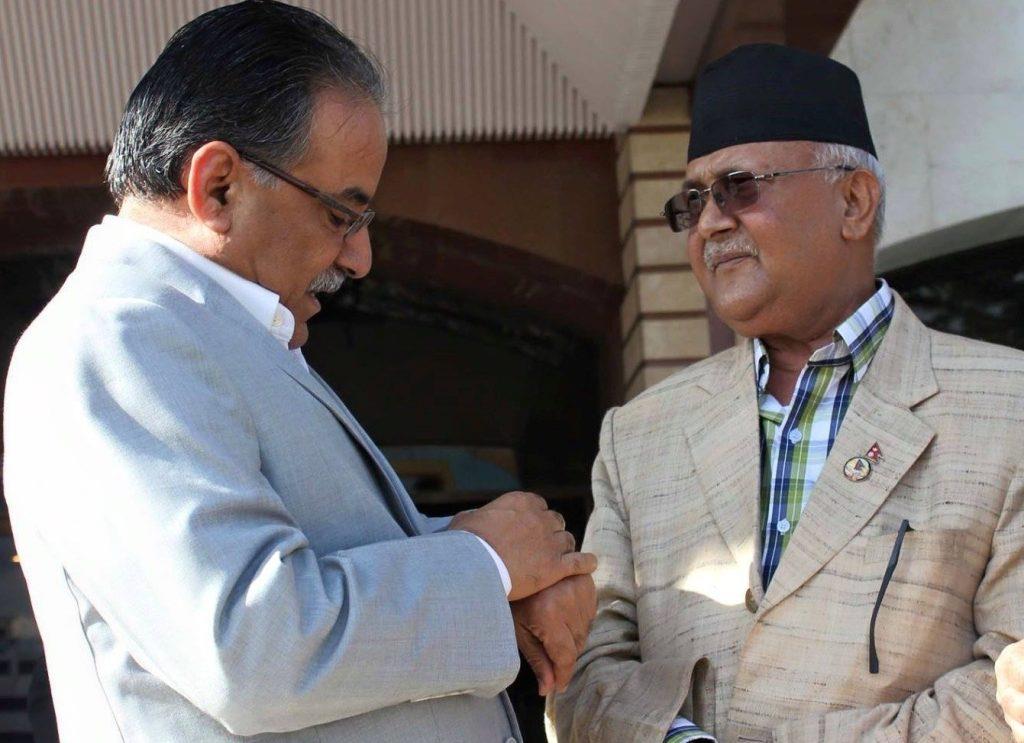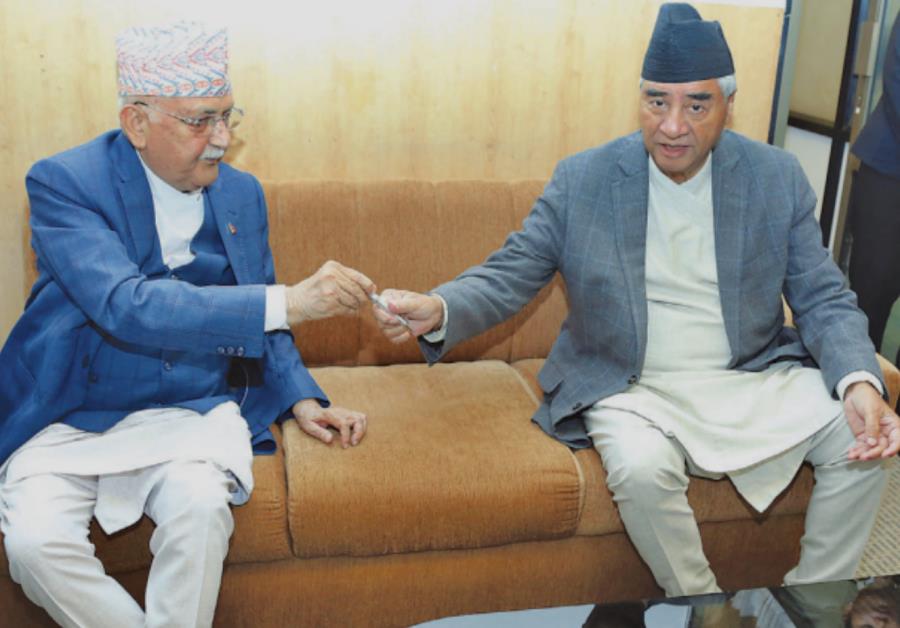
Need For Political Stability And Economic Growth To Nepal
Colombo, July 17: On Monday, Nepal saw another change of government – the second in two years. This is not new as Nepal has seen 12 changes in Premiership in 16 years.
Political instability has been the hallmark of Nepalese politics, but
stability remains a fond dream. It is hoped that the new coalition of the Nepali congress (NC) led by Sher Bahadur Deuba and the Communist Party of Nepal (United Marxist Leninist) led by P Oli will last till the next elections to the House of Representatives (HoR) in 2027.
Sceptics say that the combination will not last because the Nepali Congress is Centrist, pro-India and faction-ridden, while the CPN (UML) is communist, pro-China and centralised in its structure.
But optimists point out that Oli and Deuba have been in coalition multiple times earlier, and that both are septuagenarians with decades of experience in government.
History of Collaboration
Oli and Deuba were part of the Sushil Koirala-led government in February 2014. The Nepali Congress-CPN (UML) administration was formed with a mandate to promulgate the Constitution, which they successfully did in September 2015.
The two leaders first collaborated in the Krishna Prasad Bhattarai-led government in 1990. The mandate of that government was to promulgate the Constitution and hold the first parliamentary elections after the reinstatement of multiparty democracy in 1990.
After that, they ran a coalition government in 1996, led by Girija Prasad Koirala. That government was formed to hold general elections amid a challenging time because the CPN (Maoist Centre) had launched a Maoist insurgency.
Oli and Deuba collaborated in the G.P. Koirala government formed after the Second People's Movement in 2006 that produced the Interim Constitution of 2007.
In the first Constituent Assembly too, the NC and the CPN (UML) shared power. That was the first time the Congress was in a government led by a CPI (UML) leader.
In 2009, NC supported the then CPN (UML) leader Madhav Kumar Nepal who became Prime Minister after the fall of the Pushpa Kamal Dahal Prachanda's CPN (MC) government.
The CPN (UML)-NC government sworn-in on Monday, replaced a government run by a coalition between the CPN (UML) and the CPN
(Maoist Centre) with Pushpa Kamal Dahal alias Prachanda of the CPN (MC) as Prime Minister. Prachanda and Oli had quarrelled over several issues and the Oli ditched the coalition.
The major issue between them was over constitutional amendments. The CPN (UML) and NC shared the same view, while the CPN (MC) had an opposite view.
Current Situation
Presently, Oli has the support of 166 HoR members (NC's 88 and CPN-UML's 78) in the 275-strong House. The number needed to form a government was 138.
The two parties had also reached a tentative deal on the division of ministerial portfolios. As per an understanding, NC would head 11 ministries, including home, and UML nine, including finance. But Oli will be PM with a term of one and a half years after which he will hand over the baton to Deuba.
Controversial Constitutional Changes
As stated earlier, the CPN (UML) and CPN (MC) broke up over key amendments to the 2015 Constitution proposed by the CPN (UML) and the Nepali Congress. The CPN (MC) was opposed to these proposals.
CPN (UML) and Nepali Congress want to adopt a 100% First-Past-the-Post System (FPPS) for the House of Representatives and the Provincial Assemblies in place of the existing mixed FPPS and Proportional Representation System (PRS).
As per Nepal's electoral system, 165 members of parliament (House of Representatives) are elected under the First-Past-the-Post System and 110 under the Proportional Representation (PR) system.

Pushpa Kamal Dahal alias Prachanda with P Oli
The 550 members of the seven Provincial Assemblies are also elected under the mixed FPPS-PR system.
The Nepali Congress and the CPN (UML) blame the electoral system for political instability in Nepal and argue that the First Past Post System will ensure stable and strong governments.
But the CPN (MC) is opposed to 100% FPPS on the grounds that it will only benefit the upper castes and upper classes (the so-called Khas-Arya group). Tribal and religious minorities will also not have a voice under FPPS.
Those of this view point out that the Khas-Arya group accounted for 70% of the membership in parliament until the PRS was introduced.
There are other contentious issues in the constitution which need to be attended to, such as the delimitation of provincial boundaries to reflect community interests. Communities want to get the maximum benefit from delimitation.
The Tharu community has been demanding a separate province as they are losing out in the Madesh province, where they are only 5% of the population. There is also a demand for the delineation of electoral constituencies for better community representation.
But a constitutional amendment is easier said than done. It requires two-thirds majority in both the Lower House and the Upper House to pass the amendments. But the combined strength of the Nepali Congress and the CPN (UML) is short of a two-third majority.
Reviving the Economy
Reviving the Nepalese economy after the COVID pandemic is a major task before the government. The economy suffers from some inherent flaws also. These need to be corrected if it is to grow.
Private investment has remained sluggish, as evidenced by decreased imports of capital and intermediate goods. Public investment contracted, driven by austerity measures and low revenue collection.
The private sector has pumped four times more money than the government into the national economy. The government has to invest more. Economists say that there is no environment for Nepal to achieve a double-digit economic growth rate in the immediate future due to the low investment from the government.
Kamlesh Agrawal, president of the Nepal Chamber of Commerce, is quoted in the media as saying that the government data show the economy has slowed down, particularly in the retail, wholesale, construction and manufacturing sectors
Employment generation has suffered because of low investment. Given the lack of opportunities in Nepal young men, both skilled and unskilled, are seeking jobs abroad. Though they send remittances which keep the economy afloat, Nepal is drained of skilled labour.
Government should invite foreign investors, encourage export-oriented businesses and the tourism industry on a priority basis, it is suggested.
The situation in the banking and financial sector is worrisome. The balance sheets of most banks are not encouraging according to the government's report. If this situation is overlooked, it may have multiple impacts.
Sunil KC, president of the Nepal Bankers Association, has said:“Currently, commercial banks can lend Rs.500 billion, but the private sector is unable to borrow. This shows low confidence in the private sector to invest.”
The banking and financial sectors have more than 50 million accounts, but only 1.8 million are taking loans it is pointed out.
Non-performing loans of the banks are increasing. Sunil KC said that the non-performing loans are high in the construction sector as the government has not been able to make payments on time.
The budget for the current fiscal year increased the customs rates to earn revenue but import taxes have increased smuggling.
There are 500 unregistered SMEs. The government should come up with a challenge fund to support them to increase investment.
Foreign investors are levied an additional 10% tax which needs to be waived completely, experts say.
But to do all this, there should be a stable government in Kathmandu, it is pointed out.
END

Legal Disclaimer:
MENAFN provides the information “as is” without warranty of any kind. We do not accept any responsibility or liability for the accuracy, content, images, videos, licenses, completeness, legality, or reliability of the information contained in this article. If you have any complaints or copyright issues related to this article, kindly contact the provider above.
Most popular stories
Market Research

- Manuka Honey Market Report 2024, Industry Growth, Size, Share, Top Compan...
- Modular Kitchen Market 2024, Industry Growth, Share, Size, Key Players An...
- Acrylamide Production Cost Analysis Report: A Comprehensive Assessment Of...
- Fish Sauce Market 2024, Industry Trends, Growth, Demand And Analysis Repo...
- Australia Foreign Exchange Market Size, Growth, Industry Demand And Forec...
- Cold Pressed Oil Market Trends 2024, Leading Companies Share, Size And Fo...
- Pasta Sauce Market 2024, Industry Growth, Share, Size, Key Players Analys...





















Comments
No comment